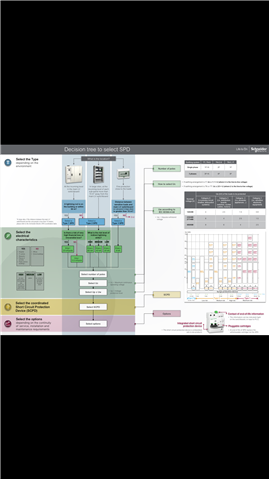
Located at intake and is Type 1. Has a Up of 1.5KV so can one assume it covers all categories set out in Table 443.2?
I find this entire subject rather confusing! May I check please?
I think that I understand the concept of cascading levels of protection so that a Type 1 SPD reduces the impact of whatever passes down a lightning protection system and is designed to protect the pretty robust stuff at the origin. If you do not have a LPS, you do not need type 1. Put another way, as Jam seems to be saying, the equipment at the origin needs to be able to withstand a relatively high impact voltage.
Type 2 deals with the lower voltage disturbances which come down the supply. They can let through enough energy to fry delicate equipment, which is where Type 3 comes in; however without Type 2 upstream, a Type 3 SPD on its own would be fried.
My main difficulty is with 534.4.4.2: "If the distance between the SPD and equipment to be protected (protective distance) is greater than 10 m ... Consideration should be given to the provision of additional coordinated SPDs ..."
I take this to mean that even if you have a Type 2 SPD at the origin (which lyledunn's may or may not be), if a distribution circuit is greater than 10 m in length, you need another Type 2 SPD at the next/final DB.
It also brings into question the purpose a Type 2 SPD at the origin if there is no sensitive equipment upstream of the DB which does supply it. Why not just install Type 2 SPD at the final DB(s).
I find this entire subject rather confusing! May I check please?
I think that I understand the concept of cascading levels of protection so that a Type 1 SPD reduces the impact of whatever passes down a lightning protection system and is designed to protect the pretty robust stuff at the origin. If you do not have a LPS, you do not need type 1. Put another way, as Jam seems to be saying, the equipment at the origin needs to be able to withstand a relatively high impact voltage.
Type 2 deals with the lower voltage disturbances which come down the supply. They can let through enough energy to fry delicate equipment, which is where Type 3 comes in; however without Type 2 upstream, a Type 3 SPD on its own would be fried.
My main difficulty is with 534.4.4.2: "If the distance between the SPD and equipment to be protected (protective distance) is greater than 10 m ... Consideration should be given to the provision of additional coordinated SPDs ..."
I take this to mean that even if you have a Type 2 SPD at the origin (which lyledunn's may or may not be), if a distribution circuit is greater than 10 m in length, you need another Type 2 SPD at the next/final DB.
It also brings into question the purpose a Type 2 SPD at the origin if there is no sensitive equipment upstream of the DB which does supply it. Why not just install Type 2 SPD at the final DB(s).
My understanding of the Up categories for equipment (like computers) belongs to Category I (Table 443.2) which has a lower rated impulse voltage of 1.5kV for a 230V nominal voltage because it’s not generally as critical as the service entrance electricity meter which needs to be rated at 6Kv. This means the SPD with a Up of 1.5Kv can protect this equipment if it is connected at this point, because the SPD will turn on at 1.5 Kv and limit the overvoltage. Usually, this equipment is not close to the source and can have this lower category, unlike a meter which needs 6 Kv. I find this to be useful:

The 10m thing is due to the fact that (for reasons I don't pretend to comprehend) beyond 10m you can get some sort of ringing or resonance affect whereby the peak voltage may double. So if an SPD at a DB kind of reduces the spike to 1.5kV, then further than 10m away you may get a 3kV spike.
Type 1s are optimised for handling a long spike and are there to temporarily equipotentially bond the wiring system to the LPS system so that lightning is less likely to see a large PD between a cable and water pipe say, and thus arc between them, starting a fire. Because of that purpose, their response time and Up isn't optimised for protecting electrical equipment - that's what a type 2 is for, and why you need both. Of course, if its Up etc are within the spec for a type 2 as well, then it can be sold as a "type 1+2".
We're about to take you to the IET registration website. Don't worry though, you'll be sent straight back to the community after completing the registration.
Continue to the IET registration site